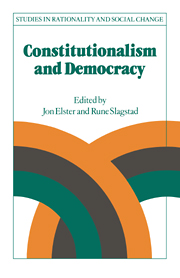Book contents
- Frontmatter
- Contents
- Notes on contributors
- Introduction
- 1 Gag rules or the politics of omission
- 3 Democracy as a contingent outcome of conflicts
- 3 Consequences of constitutional choice: reflections on Tocqueville
- 4 Liberal constitutionalism and its critics: Carl Schmitt and Max Weber
- 5 Democracy and the rule of law: some historical experiences of contradictions in the striving for good government
- 6 Neo-federalism?
- 7 Precommitment and the paradox of democracy
- 8 American constitutionalism and the paradox of private property
- 9 From liberal constitutionalism to corporate pluralism: the conflict over the enabling acts in Norway after the Second World War and the subsequent constitutional development
- 10 Arguments for constitutional choice: reflections on the transition to socialism
- 11 Constitutions and democracies: an epilogue
- Index
3 - Democracy as a contingent outcome of conflicts
Published online by Cambridge University Press: 05 June 2012
- Frontmatter
- Contents
- Notes on contributors
- Introduction
- 1 Gag rules or the politics of omission
- 3 Democracy as a contingent outcome of conflicts
- 3 Consequences of constitutional choice: reflections on Tocqueville
- 4 Liberal constitutionalism and its critics: Carl Schmitt and Max Weber
- 5 Democracy and the rule of law: some historical experiences of contradictions in the striving for good government
- 6 Neo-federalism?
- 7 Precommitment and the paradox of democracy
- 8 American constitutionalism and the paradox of private property
- 9 From liberal constitutionalism to corporate pluralism: the conflict over the enabling acts in Norway after the Second World War and the subsequent constitutional development
- 10 Arguments for constitutional choice: reflections on the transition to socialism
- 11 Constitutions and democracies: an epilogue
- Index
Summary
Anyone who has lived through moments when a dictatorship was about to fall and democracy become a real possibility remembers almost constant tension, hopes that repeatedly alternated with fears, outbursts of enthusiasm and the pain of defeat. Every step seems difficult and yet nothing seems out of reach. But as one looks for the turning-points, a particular moment appears as a threshold, as a break. At one moment dictatorship has disappeared and has been replaced by democracy.
Since this is a “moment” in a world of stylized facts, let me first provide some context, a sort of logical chronology of the processes of transition from dictatorship to democracy. Without entering into a general discussion of authoritarian regimes, which has recently received extensive attention in the work of Juan Linz and Guillermo O'Donnell, I wish to emphasize one characteristic of authoritarian systems (which I will also call “dictatorships,” abandoning some important distinctions). The essential feature of such regimes is that someone has an effective capacity to prevent political outcomes that would be highly adverse to their interests. That “someone” can be an individual, the leader, or an organization, such as the armed forces, the police, the party, or the bureaucracy, or even a less easily identifiable “ring” of groups and individuals. I will speak below of the “authoritarian power apparatus” and introduce distinctions only when they are enlightening for the problem at hand.
- Type
- Chapter
- Information
- Constitutionalism and Democracy , pp. 59 - 80Publisher: Cambridge University PressPrint publication year: 1988
- 92
- Cited by

